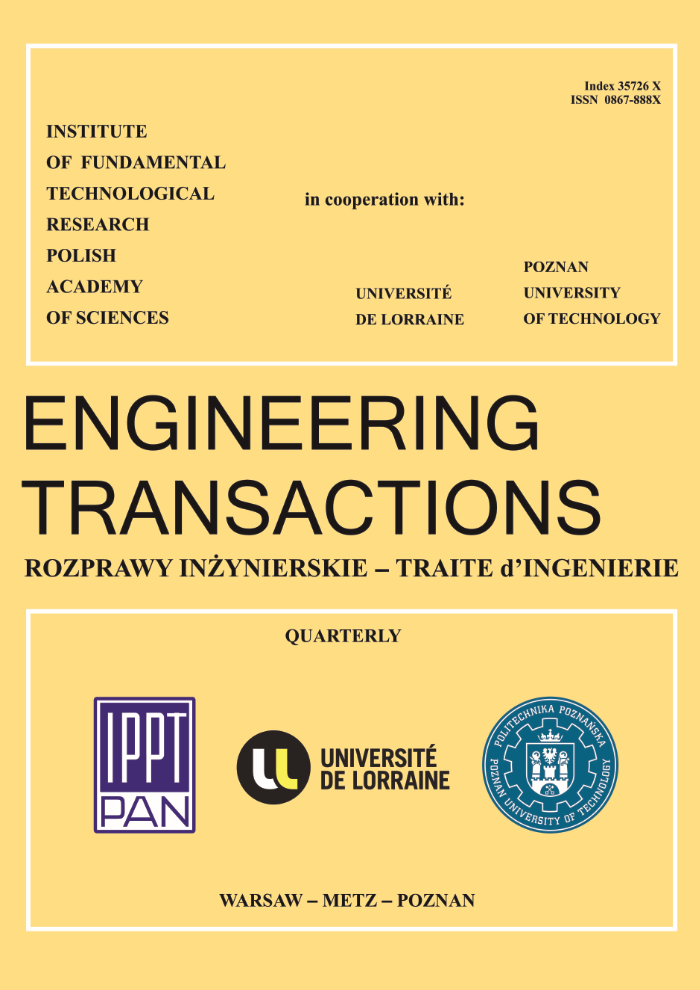On the Static Nature of Minimal Kinematic Boundary Conditions for Computational Homogenisation
Abstract
In the paper, the concept of minimal kinematic boundary conditions (MKBC) for computational homogenisation is considered. In the presented approach, the strain averaging equation is applied to the microscopic representative volume element (RVE) via Lagrange multipliers, which are, in turn, interpreted as macroscopic stresses. It is shown that this formulation fulfil automatically Hill-Mandel macrohomogeneity condition. Also, it is demonstrated, that MKBCs are in fact static, Neumann kind boundary conditions. As a consequence the effective parameters computed with this approach are lower bounds of the true effective values. Numerical analysis illustrating these results is also provided.Keywords:
RVE, minimal kinematic boundary conditions, MKBC, computational homogenisationReferences
[1] Feyel F., A multilevel finite element method (FE 2) to describe the response of highly non-linear structures using generalized continua, Computer Methods in Applied Mechanics and Engineering, 192(28–30), 3233–3244, 2003. https://doi.org/10.1016/S0045-7825(03)00348-7.
[2] Kousnetsova V.G., Geers M.G.D, Brekelmans W.A.M., Computational homogenisation for non-linear heterogeneous solids, [in:] Multiscale Modeling in Solid Mechanics. Computational Approaches, Galvanetto U., Ferri Aliabadi M.H. (Eds.), Computational and Experimental Methods in Structures, Vol. 3, Imperial College Press, London, pp. 1–42, 2009.
[3] Mesarovic S.D., Padbidri J., Minimal kinematic boundary conditions for simulations of disordered microstructures, Philosophical Magazine, 85(1), 65–78, 2005, https://doi.org/10.1080/14786430412331313321.
[4] Inglis H.M., Geubelle P.H., Matouš K., Boundary condition effects on multiscale analysis of damage localization, Philosophical Magazine, 88(16), 2373–2397, 2008, https://doi.org/10.1080/14786430802345645.
[5] Jänicke R., Steeb H., Minimal loading conditions for higher-order numerical homogenisation schemes, Archive of Applied Mechanics, 82(8), 1075–1088, 2012, https://doi.org/10.1007/s00419-012-0614-8.
[6] Wojciechowski M., Numerical homogenisation of permeability coefficient for Darcy flow in porous media, Proceedings of 3rd Polish Congress of Mechanics & 21st Computer Methods in Mechanics, September 8–11, 2015, Gdańsk, Poland, vol. 1, pp. 101–102, 2015.
[7] Nguyen V.-D., Béchet E., Geuzaine C., Noels L., Imposing periodic boundary condition on arbitrary meshes by polynomial interpolation, Computational Materials Science, 55, 390–406, 2012, https://doi.org/10.1016/j.commatsci.2011.10.017.
[8] Wojciechowski M., Fempy – finite element method in Python, http://fempy.org., http://geotech.p.lodz.pl:5080/fempy., last access: October 2016.
[2] Kousnetsova V.G., Geers M.G.D, Brekelmans W.A.M., Computational homogenisation for non-linear heterogeneous solids, [in:] Multiscale Modeling in Solid Mechanics. Computational Approaches, Galvanetto U., Ferri Aliabadi M.H. (Eds.), Computational and Experimental Methods in Structures, Vol. 3, Imperial College Press, London, pp. 1–42, 2009.
[3] Mesarovic S.D., Padbidri J., Minimal kinematic boundary conditions for simulations of disordered microstructures, Philosophical Magazine, 85(1), 65–78, 2005, https://doi.org/10.1080/14786430412331313321.
[4] Inglis H.M., Geubelle P.H., Matouš K., Boundary condition effects on multiscale analysis of damage localization, Philosophical Magazine, 88(16), 2373–2397, 2008, https://doi.org/10.1080/14786430802345645.
[5] Jänicke R., Steeb H., Minimal loading conditions for higher-order numerical homogenisation schemes, Archive of Applied Mechanics, 82(8), 1075–1088, 2012, https://doi.org/10.1007/s00419-012-0614-8.
[6] Wojciechowski M., Numerical homogenisation of permeability coefficient for Darcy flow in porous media, Proceedings of 3rd Polish Congress of Mechanics & 21st Computer Methods in Mechanics, September 8–11, 2015, Gdańsk, Poland, vol. 1, pp. 101–102, 2015.
[7] Nguyen V.-D., Béchet E., Geuzaine C., Noels L., Imposing periodic boundary condition on arbitrary meshes by polynomial interpolation, Computational Materials Science, 55, 390–406, 2012, https://doi.org/10.1016/j.commatsci.2011.10.017.
[8] Wojciechowski M., Fempy – finite element method in Python, http://fempy.org., http://geotech.p.lodz.pl:5080/fempy., last access: October 2016.






